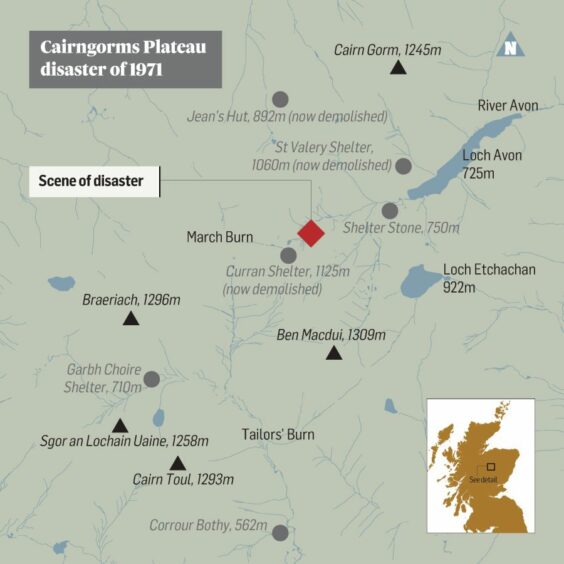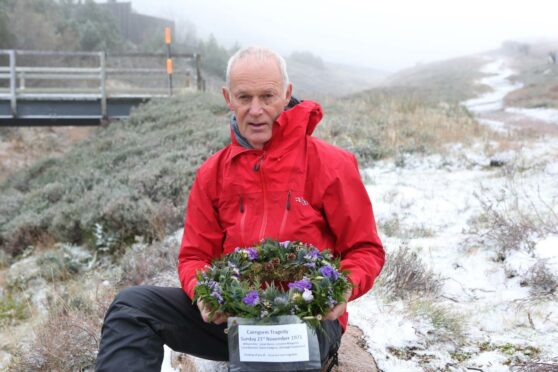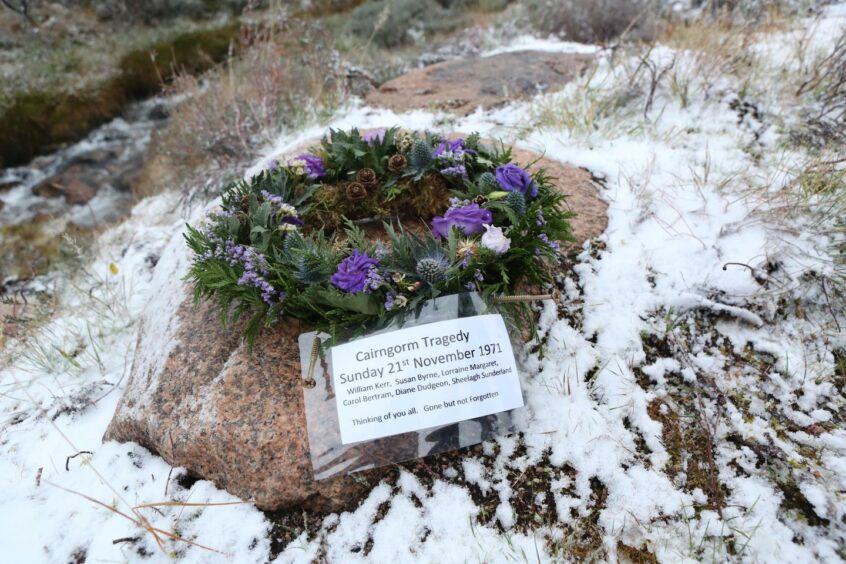A survivor of Britain’s worst mountaineering disaster has quietly marked the 50th anniversary – 3,000ft up in the hills near where his school friends perished.
John Blaikie was part of a 14-strong group of pupils from the former Ainslie Park Secondary School in Edinburgh that had headed north to explore the great outdoors.
Two groups set off to conquer Ben Macdui on November 20, 1971 but were caught out by blizzards and freezing conditions.
Five pupils died, along with their 18-year-old guide.
The Cairngorms Plateau Disaster remains the worst mountaineering disaster in British history.
‘It was devastating to lose so many friends’
Today Mr Blaikie laid a wreath on the Cairngorm plateau and said he could still “vividly remember” how the tragedy unfolded.
The retired financial advisor has now bagged all but 38 of Scotland’s 282 Munros, but it was only three years ago that he was able to return to the spot.
The group had travelled with outdoor education teacher Ben Beattie, 23, and his girlfriend Catherine Davidson, 20, and were bound for Lagganlia, Edinburgh Corporation’s new outdoor centre near Aviemore.
Mr Blaikie, 66, who has never spoken publicly about the tragedy, said: “The training we received beforehand from Ben Beattie saved my life and others in my group.
“There was about six in my group. We hit whiteout on the plateau and what saved us was the training we received with somebody going 20 yards ahead on a compass line.
“We eventually made it to the Curran shelter. It was so cold – it was a frozen icebox surrounded by stones. My balaclava was frozen to the walls. But we survived the night – we had sleeping bags.
“I couldn’t come back here until three years ago – obviously the 50 years anniversary makes it a bit more poignant. It was quite devastating (to lose so many friends) – we spent a lot of time together, canoeing, climbing, walking.”
The 66-year-old, from Kirkcudbright, added: “It is still in my memory – time dims the pain and you accept it, but you never forget it.
“I can still remember vividly that day – it never leaves you.”
Prepared walkers battered by unrelenting blizzards
Mr Beattie and Miss Davidson were experienced mountaineers and the group was well equipped for the cold weather. They were joined in the expedition by 18-year-old Sheelagh Sunderland, a trainee instructor at Lagganlia.
Mr Beattie planned the expedition, with two groups taking different routes across the Cairngorm plateau to 4,295ft high Ben Macdui.
They were then to descend and come together, spending the night at the Corrour Bothy in the Lairig Ghru mountain pass.
Mr Beattie took the more experienced, stronger walkers while Miss Davidson and Miss Sunderland took the other six – Carol Bertram, 16, and 15-year olds Diane Dudgeon, Lorraine Dick, Susan Byrne, William Kerr, and Raymond Leslie.
They set off on the walk at 11am on the November 20, 1971, but things soon began to go wrong.
The weather deteriorated and unrelenting blizzards battered both teams.
Mr Beattie’s team found their way through deep snow to a high shelter where they spent the night.
The next day his group battled their way off the plateau. It took until the late afternoon for them to reach another hut from where they could contact Lagganlia.
And that’s when it became clear the other group was in trouble.
In fact, they had never made it to the first shelter.
Caught in appalling conditions and with no hope of finding their way off the mountains, Miss Davidson took the decision that they should bivouac – camp in their sleeping bags in protective sacs – on the mountain.

Team of 50 rescuers involved in search
They spent that first night and the whole of the next day clinging to the mountain in the storm. Unable to get any distance in the blizzard, they were forced to stay a second night.
By the morning of Monday, a full-scale rescue operation was under way.
Fifty searchers from RAF Kinloss and the Aberdeen, Braemar, and Cairngorm mountain rescue teams were covering the area.
At around 10.30am, Miss Davidson was spotted by a helicopter crew. She was crawling for help. Dangerously ill, she managed to tell the rescue team where her group was huddling.
By the time the rescue arrived, five of the children and the other instructor had died. They were buried under thick snow.
Raymond Leslie was the only pupil of the six to survive the ordeal.
A fatal accident inquiry was held in Banff in February 1972, where it emerged that the parental consent forms did not say there would be winter mountaineering.
It concluded parents should in future get more information about expeditions, called for the establishment of a better training and certification regime for instructors, and recommended that experts should advise on whether high-level shelters should be removed to stop people relying on them in emergencies.
The bereaved parents called for Mr Beattie and the principal of Lagganlia, John Paisley, to be found at fault for the deaths but the inquiry would not make any such findings.
Mr Beattie continued to work in the mountains and died in a fall while climbing in the Himalayas in 1978. Miss Davidson moved to Canada.
Mr Leslie lives in Scotland and has never spoken publicly about the tragedy.
The Lagganlia Centre remains open and has introduced thousands of young people to the benefits of the outdoors. A memorial was built for the victims.

